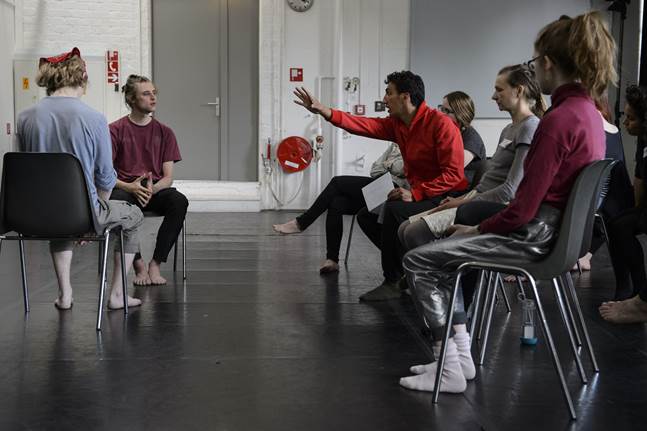
EXPERIENCE
2019 Short Course Leader, Meisner Technique masterclass, Akademiet, Copenhagen
2019 Morning Class, Exploring the voice through Meisner technique, Dansehallerne, Copenhagen
2018 Morning class, Meisner technique as
2016-2018 Drop in Teacher, Meisner technique: From presence to
2017 Short course
2017 Workshop Leader, The
2016 Short Course Leader, Introducing the Laboratory approach, Akademiet, Copenhagen
2016 Workshop Leader, Meisner technique as
THE MEISNER TECHNIQUE
The Meisner technique constantly challenges us to be in an emerging, unknown space in which socially learnt, rational control is
The technique is based on a simple partner exercise called ‘repetition’, in which the two participants repeat a series of slowly developing ‘calls’ based on their moment-to-moment observations. Meisner called the technique a ‘dumbass exercise’, where the point is not the intellectual exercise of listening and talking
In my teaching of the
THE LABORATORY APPROACH
The premise of the Laboratory is disarmingly simple, a member of the group volunteers to present work on an agreed theme. There is no rules about what form the work should take nor what the presentation should contain, all the choices as to form and content are left with the author of the work. After the presentation, the group who has watched give their reflections, associations and feedback: they offer impressions of what they saw, what they think worked or didn’t work, they offer advice about how the scene they have just watched could be adjusted to make it more effective. During the feedback process the author is silent, they don’t offer reasons for their artistic choices, nor do they correct the interpretations of the audience. The next step is that after an appropriate period, the work is re-presented, with the author having made the adjustments they think appropriate given their own experience of doing it the first time and the feedback they received. This may mean a complete overhaul of the material or minor tweaks. Again the process is repeated with the presentation being followed by the reflection and feedback of the group and again the person presenting the work is invited to go away and develop the piece further. This process goes on as long as time permits or until the material arrives at a final shape.
What is so effective with the laboratory approach is how it shows the maker their artistic and conceptual position. Often one is confronted through the feedback or through one’s experience as an audience member of blind spots in one’s conceptual thinking and/or things that as a maker one has rightly or wrongly taken for granted. It also encourages the vocabulary of the maker when they are in the position of the one offering feedback. Ultimately it offers the author a chance to develop an independence of mind and courage of conviction; not all the feedback they hear will they think is worth taking thus they come closer to understanding what is important for them and what is not.
The technique was introduced to me in 2011 by Bojan Jablanovic director of the experimental Slovenian theater company Via Negativa. It created a complete revolution in me as an performer and maker because it forced me to question all of the unconsciously held beliefs that had been installed in me through a classical acting training and my years of viewership. It cleaned the slate and made me start again with the most basic premise of the stage: the relationship between audience and performer.